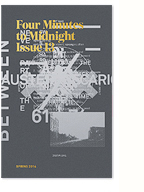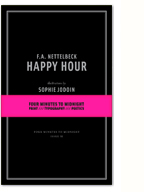
Originally published February 5 2003
Josh On is an interactive designer working at Futurefarmers and the author of the acclaimed theyrule.net, an interactive mapping application that reveals the interconnections between the CEOs of the US’s largest corporations. I’ve always been inspired by his work, and was pleased to have the opportunity to ask him a few questions on design and social responsibility.
You’re probably best known for your role as a partner at Futurefarmers, alongside founder Amy Franceschini. How did you come to work for and eventually become a partner at Futurefarmers?
I am only unofficially a partner. Futurefarmers is really Amy’s project, though I am really happy to be a part of it. It is an umbrella under which she does a lot of work with a lot of different people. I like the general philosophy of doing some work to make some money, and then using that money for personal and political projects. I first came over to Futurefarmers as an intern in 1999. I was a student at the Royal College of Art in London, and was blown away by Futurefarmer’s projects. I came back after I graduated in 2000.
The research you did while at RCA is centered around questions on how computers and digital technology mediate communication and are therefore inherently political instruments. Many of your investigations there, and at Futurefarmers, deal with the social role of the interface. Could you speak a little further about these ideas?
I think that the forms and formats of communication are really important. I believe that the role of the interaction designer is to shape these forms so that they are best suited to the types of communication that a particular task or group requires.
If all that is required is a vote, then a check box might be an appropriate interface. If discussion is needed on the vote, and the participants can not meet in a room at the same time, then perhaps an email list might be a good addition to the checkbox!
I am interested in finding new formats, like the check box and the mailing list. I think we have taken the approach of playing around with formats and then seeing what they might be used for. Now I’d like to drive our creativity more from the other direction. We have a lot of ideas about possible formats that haven’t been made, but it is hard to find funding for them. I’d rather try and work with real groups and real problems and apply new or old solutions to them.
The Theyrule project is a strong example of these ideas. It has gained considerable attention, being featured in everything from Adbusters to the Whitney Biennial 2002. What was the inspiration behind the project and what kinds of feedback have you received?
Theyrule brought together a lot of my interests. I am a socialist, and so presenting an image of an aspect of the ruling class in a visual way was very inviting. I was exploring making something of a who owns whom kind of site, which turned out to be very difficult. In the process I was looking at a lot of annual reports and seeing the boards of directors listed, I remembered hearing about how densely interconnected they were. At first I collected the information on the top 10 companies. I think that was with year 2000 data, but just within that one man, Lucio Noto was on 3 or 4 of them. I was fascinated with the information, so I pursued it. In 2001 92 of the US Fortune 100 companies had interlocking directories with other Fortune 100 companies.
I wanted people to be able to explore the data for themselves, and draw their own conclusions. By making the icons of the directors fat and calling the site “they rule” I hope I got over my opinion of the situation!
The feedback has been great. People send in a lot of ideas for expanding and adapting it. There is a lot of room for designers to be making interactive information graphics with political content. Hopefully we will see more of it, though on the most part it will have to be a labor of love!
Another Futurefarmers project that I find really interesting is the Communiculture website. What were the ideas behind this work and how do you see it being developed further?
Communiculture started as a project at the RCA in London. It was called “Prototype World”. I expanded on it a bit with Amy and Brian Won at Futurefarmers. It is a tool that allows people to place avatars of themselves on a “continuum” (excuse the terrible Latin!) between two opposing positions. Again this was meant to be an experimental format, an elaborate check box, and not necessarily a stand alone application. I have long wanted to work on a project like groups.yahoo.com or smartgroups.com and develop tools for groups of people. Unfortunately the opportunity has not yet arisen, but that is the sort of direction that I see communiculture going. There is so much that could be done to develop these already very useful resources.
A lot of the work Futurefarmers creates expresses a clear commitment to social, political and environmental issues. Is there a conflict that arises between the commercial work the studio pursues and its autonomous projects?
For sure. I should speak for myself here. I take a socialist line on this. I spend much of my ‘free time’ organizing for what I see as the necessary overthrowing of the capitalist system. On a day to day level that means helping to organize in existing fights within the system, whether that is to back Nader’s campaign in the election, to fight for public electricity and gas, or to stop the war on Iraq. I think that helping to build the movements around these issues and to tie the causes of environmental and social destruction to the profit driven dynamics of capitalism is a key task.
I work to make money. It isn’t that confusing for me. I see the contradiction, but it is not one that stems from my internal conflicts, but rather from the contradictions in the system. We need to eat and be sheltered, and have some healthcare etc. In this system that means that you have to make some money. In order to do that I am probably going to have to work for something that is pretty wrong. Even if I was a school teacher, which is to be sure a more noble profession, I would have to deal with the fact that schools are not designed to teach children to be self motivated thinkers but rather train obedience and discipline, perfect qualities for a workforce. If at some point I might be able to sustain myself doing more revolutionary work, that would be great. Or perhaps we will have a revolution and then who knows what amazing opportunities might present themselves?
Some people like to abstain from the system. I don’t believe it is possible, and it avoids the question of transforming the system. A permaculture farm, is a great thing, don’t get me wrong, but it is not the solution to the world’s environmental problems. I would like to see us interact with the earth with a balanced metabolism, but we have to take on the system that drives us to do otherwise, and I believe that that is the forces of competition that create the anarchy of the market. Even permaculture farmers need healthcare, pay taxes, etc. We should be talking seriously about what power we have to transform society into a rationally structured entity.
‘Political Activism’ seems to have come into vogue within the graphic design community over the last few years. What do you think is the general motivation behind this trend? Do you see it as ‘sincere’ or as more of a commercial co-optation of real social issues, as is perhaps best represented by DIESEL’s recent marketing campaigns?
I think that the general motivation behind the ‘trend’ is that people are confronted with a world on the brink of an environmental, military, and economic crisis. We are compelled to engage with this reality. I think that different individuals and organizations have done this differently. Some have prioritized the importance of designers in the ability to change the world. I do think that we need to act, but I think that it is not as the harbingers of truth, but really as fellow activists. We can bring our skills to the movement, but be humbly aware that the organized power of designers is maybe not as significant as the organized power of the dockworkers for example. If they went on strike against the war, it would have an immediate effect on the economy, as the lockout of the US westcoast longshore workers showed.
I don’t buy into the idea that the real problem in society is that people are duped by advertising and propaganda. I do believe those things play a negative role in society, but I think the real problem is that people don’t have a confidence in their own power to transform and govern society from below. That is something that can only be won in practice, in struggle. The working class, including much of the middle class has taken a real beating over the last twenty years. It is time to win some victories to get up our confidence. That is why I am so excited by this anti-war movement. I urge all, everyone (designers included) to get involved in the anti-war movement locally. If you can’t find a group that is run democratically, and debates the larger politics, then start one yourself. Make it open, make some flyers and invite people along to discuss and organize against the war.
As far as Diesel is concerned, I believe that is a purely aesthetic affair. It seems pretty irrelevant in the larger scheme of things. I wonder if it helped them sell more product, that is the way they will evaluate it.
At the end of the recent Futurefarmers publication, Harvest, there’s an interesting reading list section? You mention Howard Zinn’s “A People’s History of the US” as one of your top choices. Why do you think this is such an important book?
Zinn is a very important US scholar. I wanted to acknowledge him in my reading list, along with Lenin, and Marx, Luxemburg and other contemporary socialists. Once I heard Zinn say that we should not leave the important political decisions to the politicians. He is an activist and an historian. He is a great model. I hope I can stay active as long as him. As for that book in particular, I know it has inspired many people to become more active. To me that is the sign of a great book.
Aside from Victor Papanek’s “Design for the Real World” there are no other design-related books in your list. Are you inspired by any designers, and if so, by who?
I like a lot of designers and their writings, but I don’t always politically agree with them. Despite all that I have said, I do believe that there is a lot of beautiful, critical, and functional design being created inside and outside of the corporate world. I like much of Bonnie Nardi, Brenda Laurel, Anthony Dunne, Fiona Raby, Joe Sacco, and Greyworld’s design and writings to name just a few. I guess I am mostly inspired by those who are actively involved in struggle, and I see the most important struggles to lie beyond the world of design.
Thanks Josh!
No Comments so far
Leave a comment
Leave a comment














